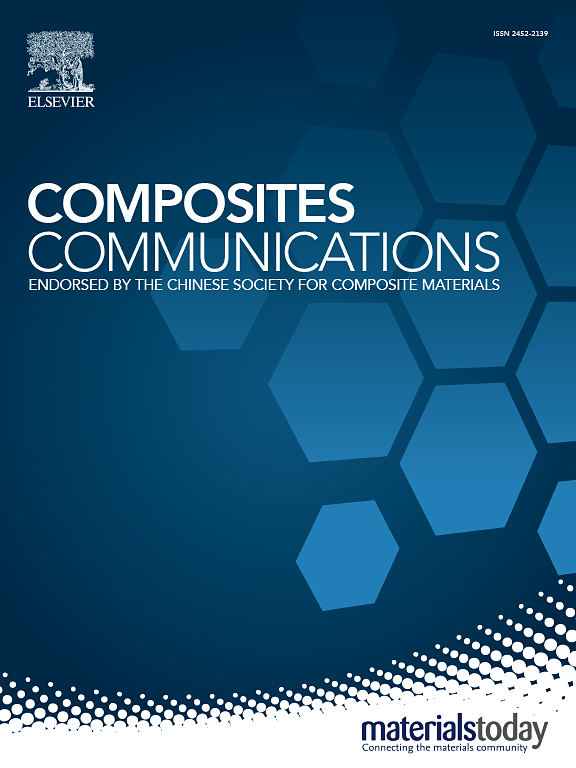Robust and washable silk fiber-based electrochemical biosensor for high-performance sensing of hydrogen peroxide
IF 6.5
2区 材料科学
Q1 MATERIALS SCIENCE, COMPOSITES
引用次数: 0
Abstract
Wearable electronics, especially fiber-based biosensors, show promise in large-scale production and reusability compared with conventional wafer-based electronics. However, it is challenging to use wearable electronics, with less intensity and non-wash ability, to produce fiber-based biosensors for textiles. Here, a robust and washable Prussian blue (PB)-functionalized silk fiber (PB-SF) flexible electrode is reported. Modified cyanotype is successfully employed to immobilize PB nanoparticles (∼18.32 nm) onto silk fibers for hydrogen peroxide (H2O2) detection. The intrinsic mechanical properties of silk fibers are well maintained with slight increases in stress (∼10 %) and strain (∼16 %). Furthermore, the PB-SF electrode displays good electrochemical H2O2 sensing performance with a sensitivity of 716.54 μA/mM·cm2, a linear range of 0.01–0.6 mM and a low detection limit of 10 μM (S/N = 3). Notably, the hybrid PB-SF electrode adapts to mechanical deformations with a series of angles and the electrical signals are not compromised obviously even after 100 home laundry washing cycles. PB modified silk fibers is simple, easy-operating and cost-effective electrode that is suitable for large-scale production as it can be integrated into e-textiles through typical textile processing methods.
坚固耐用、可清洗的丝纤维电化学生物传感器,用于高性能检测过氧化氢
与传统的晶圆电子器件相比,可穿戴电子器件,尤其是纤维生物传感器,在大规模生产和重复使用方面前景广阔。然而,使用强度较低且不可水洗的可穿戴电子设备来生产纺织品用纤维生物传感器具有挑战性。本文报告了一种坚固耐用且可水洗的普鲁士蓝(PB)功能化丝纤维(PB-SF)柔性电极。改性氰基成功地将普鲁士蓝纳米颗粒(18.32 nm)固定在丝纤维上,用于过氧化氢(H2O2)检测。在应力(∼10 %)和应变(∼16 %)略有增加的情况下,蚕丝纤维的固有机械性能保持良好。此外,PB-SF 电极具有良好的电化学 H2O2 检测性能,灵敏度为 716.54 μA/mM-cm2,线性范围为 0.01-0.6 mM,检出限低至 10 μM(S/N = 3)。值得注意的是,PB-SF 混合电极能适应一系列角度的机械变形,即使经过 100 次家庭洗衣循环,电信号也不会受到明显影响。PB 改性蚕丝纤维是一种简单、易于操作且成本效益高的电极,可通过典型的纺织加工方法集成到电子纺织品中,因此适合大规模生产。
本文章由计算机程序翻译,如有差异,请以英文原文为准。
求助全文
约1分钟内获得全文
求助全文
来源期刊

Composites Communications
Materials Science-Ceramics and Composites
CiteScore
12.10
自引率
10.00%
发文量
340
审稿时长
36 days
期刊介绍:
Composites Communications (Compos. Commun.) is a peer-reviewed journal publishing short communications and letters on the latest advances in composites science and technology. With a rapid review and publication process, its goal is to disseminate new knowledge promptly within the composites community. The journal welcomes manuscripts presenting creative concepts and new findings in design, state-of-the-art approaches in processing, synthesis, characterization, and mechanics modeling. In addition to traditional fiber-/particulate-reinforced engineering composites, it encourages submissions on composites with exceptional physical, mechanical, and fracture properties, as well as those with unique functions and significant application potential. This includes biomimetic and bio-inspired composites for biomedical applications, functional nano-composites for thermal management and energy applications, and composites designed for extreme service environments.
 求助内容:
求助内容: 应助结果提醒方式:
应助结果提醒方式:


